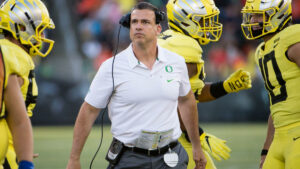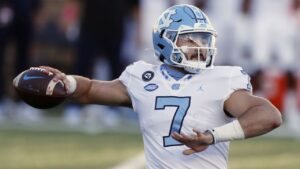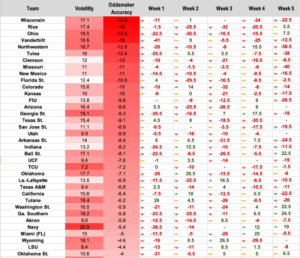
Written by Drew Borland of SportSource Analytics
When it comes to betting totals there’s always a question that comes to mind: ”what should a bettor be rooting for in the game as it unfolds”? Do you want a blowout? A close game? Do you want the underdog to cover or the favorite to run away with the game?
Deep Diving the Data
Let’s take a look at how betting college football games have fared since 2020.
First, let’s tackle the general competitiveness of the game. We’ll measure this with “Average Score Differential Per Play”. This is an easy calculation that takes every play of the game and averages the absolute scoring differential. It’s pretty simple; if the game is tied 0-0, the differential for that play is 0. If it is 14-0, it is 14. Averaging that out for an entire game, we’ll have a good approximation if games are close (small average differential) or non-competitive (big average differential).
Subscribe to Bet The Board Podcast ?
Apple Podcasts: apple.co/3mdGgbz
SoundCloud: bit.ly/3bR66gK
Google Podcasts: bit.ly/2RgfdxR
Spotify: spoti.fi/3jjDJwL
Tackling Totals
Now let’s see how Overs and Unders did against this metric.
- Games the Over hit had an Average Score Differential Per Play of 13.4 points.
- Games the Under hit had an Average Score Differential Per Play of 10.0 points.
Place all your Football Bets and More at Fanduel.com/BetTheBoard
Overs are 34% less competitive than Unders. The average Over has 67.5 points per game and the average Under has 43.7. Less points generally could account for the increased competitiveness of any given game. However, the conclusion is still simple; sizable score differentials necessitate more offense with pace of play and style adjustments.
Adding Layers
Another layer worth addressing is big blowouts. We’re talking about 35+ point blowouts that occur 8 to 10 times a weekend on the college football ticker or Sunday’s with the Houston Texans.
- Games the point differential is 35+, the Over is 101-49 (67.3%)
- Games the point differential is 14 to 34, the Over is 193-214 (47.4%)
Clearly, if you are holding that Over ticket, a blowout can actually be your best friend. This now begs the question, should you be betting more Overs on games with larger spread differentials? That’s a completely different discussion for a future article.
Subscribe and Listen to Bet the Board’s NFL and College Football Weekly Podcasts
One Step Further
Here’s another layer to our analysis; does it matter who is doing the scoring in a game? The public generally likes to combine bets whether it is a same-game parlay or a teaser. Are there combinations of underdog/under or favorite/over that seem to be working better?
Since 2020 in College Football:
- When the Underdog Covers, the Over is 206-238 (46.3%)
- When the Favorite Covers, the Over is 110-119 (51.1%)
That ~5% difference is significant. Taking these types of wager-combination tickets consistently to the window is not something you want to bank on every week. That said, we still see these kinds of bets advocated for weekly by famous pick evangelists. Bettor beware!
Understanding what you’re rooting for in a game sheds light into how you need to look for value when betting on the total pregame or in-play. Totals are intriguing to bet and cater to a slightly more sophisticated investor but make sure they are directionally correct when it comes to identifying sides on your card as well.
Source: https://www.bettheboardpodcast.com/2021/10/26/how-to-bet-college-football-over-unders/











